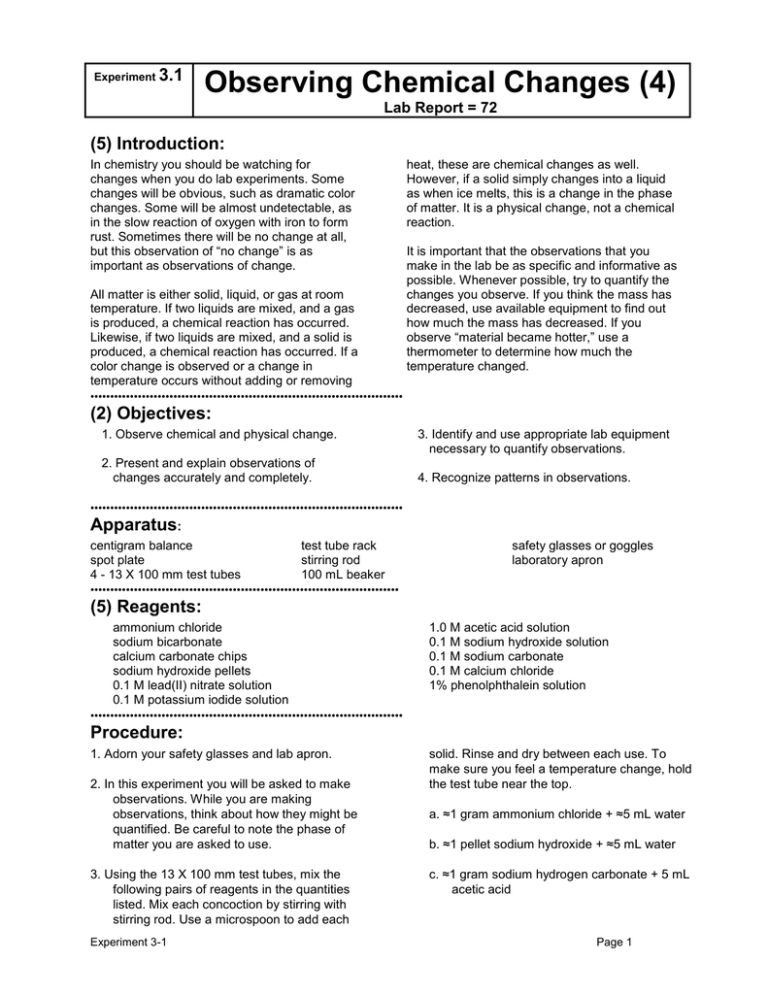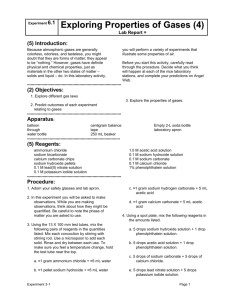Observing Chemical Changes (4) 3.1 (5) Introduction:
advertisement

Experiment 3.1 Observing Chemical Changes (4) Lab Report = 72 (5) Introduction: In chemistry you should be watching for changes when you do lab experiments. Some changes will be obvious, such as dramatic color changes. Some will be almost undetectable, as in the slow reaction of oxygen with iron to form rust. Sometimes there will be no change at all, but this observation of “no change” is as important as observations of change. All matter is either solid, liquid, or gas at room temperature. If two liquids are mixed, and a gas is produced, a chemical reaction has occurred. Likewise, if two liquids are mixed, and a solid is produced, a chemical reaction has occurred. If a color change is observed or a change in temperature occurs without adding or removing heat, these are chemical changes as well. However, if a solid simply changes into a liquid as when ice melts, this is a change in the phase of matter. It is a physical change, not a chemical reaction. It is important that the observations that you make in the lab be as specific and informative as possible. Whenever possible, try to quantify the changes you observe. If you think the mass has decreased, use available equipment to find out how much the mass has decreased. If you observe “material became hotter,” use a thermometer to determine how much the temperature changed. ••••••••••••••••••••••••••••••••••••••••••••••••••••••••••••••••••••••••••••••• (2) Objectives: 1. Observe chemical and physical change. 2. Present and explain observations of changes accurately and completely. 3. Identify and use appropriate lab equipment necessary to quantify observations. 4. Recognize patterns in observations. ••••••••••••••••••••••••••••••••••••••••••••••••••••••••••••••••••••••••••••••• Apparatus: centigram balance spot plate 4 - 13 X 100 mm test tubes test tube rack stirring rod 100 mL beaker safety glasses or goggles laboratory apron •••••••••••••••••••••••••••••••••••••••••••••••••••••••••••••••••••••••••••••• (5) Reagents: ammonium chloride sodium bicarbonate calcium carbonate chips sodium hydroxide pellets 0.1 M lead(II) nitrate solution 0.1 M potassium iodide solution 1.0 M acetic acid solution 0.1 M sodium hydroxide solution 0.1 M sodium carbonate 0.1 M calcium chloride 1% phenolphthalein solution ••••••••••••••••••••••••••••••••••••••••••••••••••••••••••••••••••••••••••••••• Procedure: 1. Adorn your safety glasses and lab apron. 2. In this experiment you will be asked to make observations. While you are making observations, think about how they might be quantified. Be careful to note the phase of matter you are asked to use. 3. Using the 13 X 100 mm test tubes, mix the following pairs of reagents in the quantities listed. Mix each concoction by stirring with stirring rod. Use a microspoon to add each Experiment 3-1 solid. Rinse and dry between each use. To make sure you feel a temperature change, hold the test tube near the top. a. ≈1 gram ammonium chloride + ≈5 mL water b. ≈1 pellet sodium hydroxide + ≈5 mL water c. ≈1 gram sodium hydrogen carbonate + 5 mL acetic acid Page 1 d. ≈1 gram calcium carbonate + 5 mL acetic acid c. 5 drops of sodium carbonate + 5 drops of calcium chloride. 4. Using a spot plate, mix the following reagents in the amounts listed. e. 5 drops lead nitrate solution + 5 drops potassium iodide solution. a. 5 drops sodium hydroxide solution + 1 drop phenolphthalein solution. 5. Record all observations on the data table. 6. If in doubt on any part, repeat that part. b. 5 drops acetic acid solution + 1 drop phenolphthalein solution. 7. Clean up all materials and wash your hands thoroughly. ••••••••••••••••••••••••••••••••••••••••••••••••••••••••••••••••••••••••••••••• Data and Observations: (20) (10) (10) Data Table Chemicals Used ammonium chloride and water Sodium hydroxide pellets and water sodium hydrogen carbonate and acetic acid Calcium carbonate and acetic acid Stamp for 4 tubes................. sodium hydroxide and phenolphthalein acetic acid and phenolphthalein Sodium carbonate + Calcium chloride Lead(II) nitrate + potassium iodide Stamp for 5 wells.................. Observations ••••••••••••••••••••••••••••••••••••••••••••••••••••••••••••••••••••••••••••••• (18) Analysis and Conclusions: (8) 1. Describe in clear terms how each step of the procedure could be repeated to collect quantified data. a. ammonium chloride + water b. sodium hydroxide and water c. sodium hydrogen carbonate and acetic acid d. calcium carbonate and acetic acid e. sodium hydroxide and phenolphthalein f. acetic acid and phenolphthalein g. sodium carbonate + calcium chloride Experiment 3-1 h. lead(II) nitrate + potassium iodide (3) 2. Describe any temperature changes you observed. (2) 3. Describe any color changes you observed. (2) 4. Which combinations produced a gas? (2) 5. Which combinations produced a precipitate? Page 2 (1) 6. Which combinations resulted in no reaction? ••••••••••••••••••••••••••••••••••••••••••••••••••••••••••••••••••••••••••••••• (18) Synthesis: 1. Based on your observations, predict the results of mixing the following pairs of chemicals. Explain why you are making a particular prediction. If you cannot make a particular prediction, tell why. (4) a. magnesium carbonate + acetic acid i. prediction ii. explanation (4) b. ammonium hydroxide + phenolphthalein i. prediction ii. explanation (4) c. lead nitrate + sodium chloride i. prediction ii. explanation Experiment 3-1 (4) d. hydrochloric acid + sodium hydroxide i. prediction ii. explanation (2) 2. Suppose you wanted to collect and find the mass of a gas produced in a chemical reaction. How would you do it? Extra Credit: (10) Write and balance the complete reaction between sodium hydrogen carbonate and acetic acid, calcium carbonate and acetic acid, sodium carbonate and calcium chloride, and lead(II) nitrate and potassium iodide. Page 3






